“Global Data Center Solutions Market to reach a market value of USD 711.5 Billion by 2030 growing at a CAGR of 11.5%”
The Global Data Center Solutions Market size is expected to reach $711.5 billion by 2030, rising at a market growth of 11.5% CAGR during the forecast period.
Virtualization software allows organizations to abstract physical hardware resources and create virtual instances of servers, storage, and networking components. Therefore, the virtualization software segment captured $9,558.1 million revenue in the market in 2022. By consolidating multiple virtual machines (VMs) onto a single physical server, virtualization enables organizations to optimize resource utilization, reduce hardware sprawl, and maximize data center infrastructure efficiency.
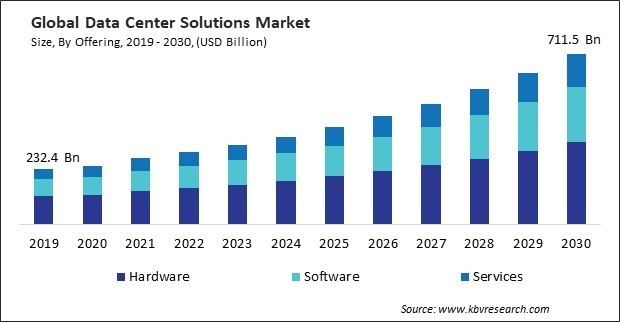
The major strategies followed by the market participants are Geographical Expansions as the key developmental strategy to keep pace with the changing demands of end users. For instance, In August, 2022, Microsoft Corporation launched a new datacenter region in Qatar. The state-of-the-art datacenters provide Microsoft Azure and Microsoft 365 services, facilitating access to scalable, highly available, and resilient cloud services and accelerating digital transformation for businesses and partners across Qatar. Additionally, In April, 2022, Google LLC is allocating a staggering $9.5 billion towards new data centers and U.S. offices, a move expected to generate "at least" 12,000 new full-time jobs by year's end.
Based on the Analysis presented in the KBV Cardinal matrix; Google LLC and Microsoft Corporation are the forerunners in the Market. For instance, In May, 2023, Microsoft Corporation has launched its latest cloud region, the first in Central and Eastern Europe, situated in Poland. This development marks a significant step in Poland's digital transformation and connects it to the world's most extensive cloud infrastructure. Companies such as Equinix, Inc., Huawei Technologies Co., Ltd., KDDI Corporation are some of the key innovators in Market.
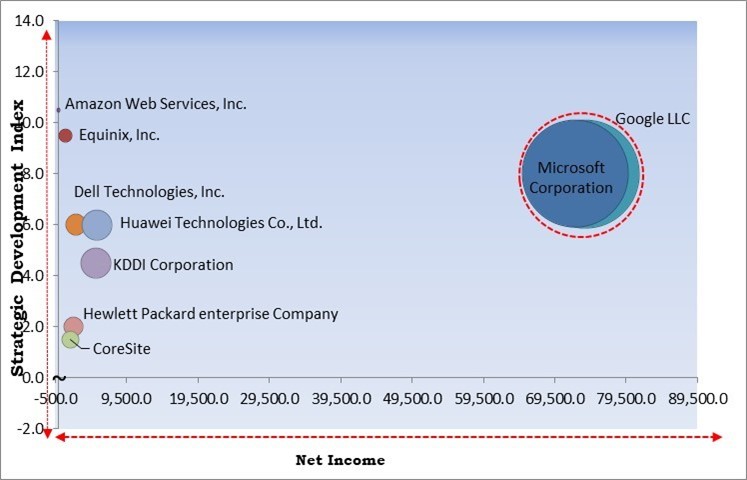
Globally, organizations are increasingly moving their IT infrastructure and services to cloud platforms, leading to a surge in demand for data centers that can support and integrate with cloud environments. Cloud computing offers scalability, allowing businesses to scale their operations and resources based on demand. These solutions become essential to provide the underlying infrastructure that supports the scalability requirements of cloud services. Therefore, the rising adoption of cloud computing is propelling the growth of the market.
Additionally, the rollout of 5G technology significantly increases data traffic due to higher data speeds and improved network capacity. The sector's firms generated a combined business profit of around 197.9 billion U.S. dollars (approximately 1.4 trillion yuan), representing a year-on-year increase of 6.9 percent. Similarly, as per the International Trade Administration, the 5G has attained 53% coverage rate in Saudi Arabia. The cumulative capital investment of Saudi Arabia in digital infrastructure surpassed $24.8 billion during the preceding six years. Thus, the increasing 5G rollout is driving the growth of the market.
Investing in compliance certifications, physical security systems, and cybersecurity measures adds to the initial costs, particularly for data-sensitive industries. Organizations often require customized data center solutions tailored to their specific needs. Designing and implementing such customized infrastructure, which is also scalable for future growth, entails additional costs contributing to the overall high initial investment. Therefore, the high initial investment hampers the growth of the market.
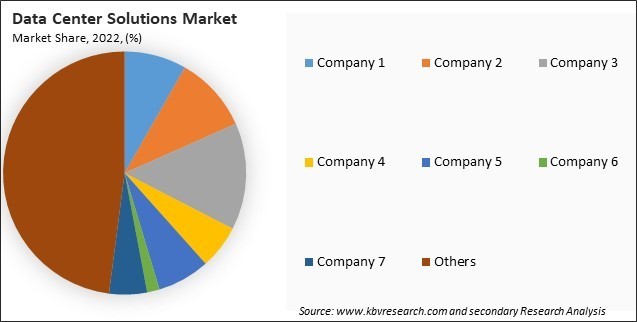
The leading players in the market are competing with diverse innovative offerings to remain competitive in the market. The above illustration shows the percentage of revenue shared by some of the leading companies in the market. The leading players of the market are adopting various strategies in order to cater demand coming from the different industries. The key developmental strategies in the market are Geographical Expansions.
Based on tier type, the market is categorized into tier 1, tier 2, tier 3, and tier 4. The tier 1 segment attained a 12.58% revenue share in the market in 2022. Tier 1 data centers represent the entry-level tier of data center infrastructure, providing basic reliability and uptime for organizations with modest IT requirements. These facilities typically offer minimal redundancy and fault tolerance, making them suitable for non-mission-critical applications and workloads that can tolerate occasional downtime.
Based on data center size, the market is divided into small data centers, mid-sized data centers, and large data centers. The large data centers segment attained 50.92% revenue share in the market in 2022. The growing demand for large data centers drives significant investments in data center infrastructure, including servers, storage systems, networking equipment, and cooling systems.
On the basis of data center type, the market is segmented into cloud data center, colocation data center, enterprise data center, modular data center, and edge data center. The colocation data center segment held a 16.81% revenue share in the market in 2022. Organizations collocate their servers and IT infrastructure in colocation data centers to benefit from the facilities' robust infrastructure, including power, cooling, security, and connectivity.
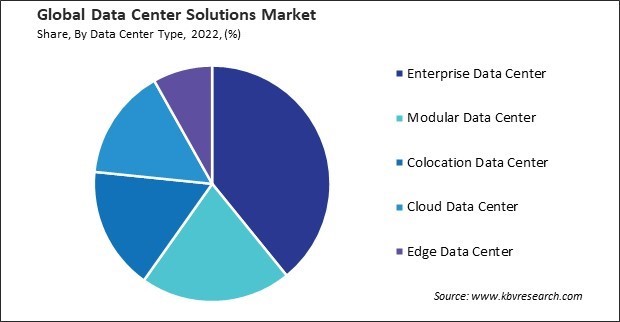
Based on offering, the market is divided into hardware, software, and services. In 2022, the hardware segment recorded 50.14% revenue share in the market. The hardware of the data center is of the utmost importance in guaranteeing data security and adherence to regulatory obligations. This includes hardware-based security features such as encryption, secure boot, and hardware-based authentication to protect data and infrastructure from cyber threats.
The hardware segment is further subdivided into IT modules, power modules, and cooling modules. In 2022, the IT modules segment garnered 43.08% revenue share in the market. IT modules offer a modular design approach that allows data center operators to scale infrastructure resources flexibly and cost-effectively. Modular IT solutions enable organizations to incrementally add computing, storage, and networking capacity as their business needs evolve, avoiding over-provisioning and minimizing upfront capital expenditures.
The services segment is further subdivided into design & consulting, integration & deployment, and support & maintenance. In 2022, the support & maintenance segment acquired 45.79% revenue share in the market. With the growing adoption of data centers across various industries, there is a greater need for support and maintenance services to ensure their continuous and efficient operation. Many businesses require their data centers to be operational 24/7 to meet the demands of a globalized, always-on economy.
The software segment is further subdivided into monitoring & management tools, automation & orchestration software, backup & disaster recovery, security software, virtualization software, and analytics software. The monitoring & management tools attained 28.21% revenue share in the market in 2022. Data center environments have become increasingly complex, encompassing diverse physical and virtual infrastructure components distributed across on-premises, cloud, and edge locations.
On the basis of vertical, the market is categorized into BFSI, IT & telecom, government & defense, healthcare & life sciences, transportation, retail, energy & utilities, manufacturing, and others. The BFSI segment garnered 24.86% revenue share in the data centers solutions market in 2022. The BFSI sector deals with sensitive customer information and is subject to strict regulatory requirements regarding data security and privacy.
Free Valuable Insights: Global Data Center Solutions Market size to reach USD 711.5 Billion by 2030
Region-wise, the market is analyzed across North America, Europe, Asia Pacific, and LAMEA. In 2022, the Asia Pacific region generated a 27.55% revenue share in the market in 2022. This region has a growing population of mobile and internet users, driving demand for data center solutions supporting mobile applications, social media platforms, and online services. Data center operators are investing in edge computing infrastructure to deliver low-latency experiences and improve performance for mobile and internet users.
| Report Attribute | Details |
|---|---|
| Market size value in 2022 | USD 302.6 Billion |
| Market size forecast in 2030 | USD 711.5 Billion |
| Base Year | 2022 |
| Historical Period | 2019 to 2021 |
| Forecast Period | 2023 to 2030 |
| Revenue Growth Rate | CAGR of 11.5% from 2023 to 2030 |
| Number of Pages | 571 |
| Number of Tables | 924 |
| Report coverage | Market Trends, Revenue Estimation and Forecast, Segmentation Analysis, Regional and Country Breakdown, Competitive Landscape, Market Share Analysis, Porter’s 5 Forces Analysis, Company Profiling, Companies Strategic Developments, SWOT Analysis, Winning Imperatives |
| Segments covered | Offering, Tier Type, Data Center Size, Data Center Type, Vertical, Region |
| Country scope |
|
| Companies Included | Amazon Web Services, Inc., Google LLC., Microsoft Corporation, Equinix, Inc., Huawei Technologies Co., Ltd., Dell Technologies, Inc., KDDI Corporation, Hewlett Packard enterprise Company, Cyxtera Technologies, Inc., CoreSite |
By Offering
By Tier Type
By Data Center Size
By Data Center Type
By Vertical
By Geography
This Market size is expected to reach $711.5 billion by 2030.
Increasing adoption of digitalization by businesses are driving the Market in coming years, however, Requirement for substantial capital expenditure restraints the growth of the Market.
Amazon Web Services, Inc., Google LLC., Microsoft Corporation, Equinix, Inc., Huawei Technologies Co., Ltd., Dell Technologies, Inc., KDDI Corporation, Hewlett Packard enterprise Company, Cyxtera Technologies, Inc., CoreSite
The expected CAGR of this Market is 11.5% from 2023 to 2030.
The Enterprise Data Center segment is leading the Market by Data Center Type in 2022; thereby, achieving a market value of $264.8 billion by 2030.
The North America region dominated the Market by Region in 2022, and would continue to be a dominant market till 2030; thereby, achieving a market value of $246.8 billion by 2030.
Our team of dedicated experts can provide you with attractive expansion opportunities for your business.
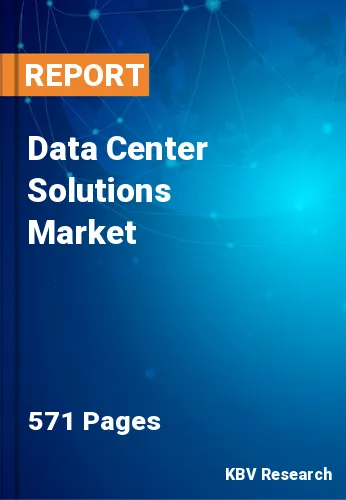
 Drivers
Drivers
 Restraints
Restraints
 Opportunities
Opportunities
 Challenges
Challenges
